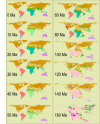An updated floristic map of the world
- PMID: 37253755
- PMCID: PMC10229591
- DOI: 10.1038/s41467-023-38375-y
An updated floristic map of the world
Abstract
Floristic regions reflect the geographic organization of floras and provide essential tools for biological studies. Previous global floristic regions are generally based on floristic endemism, lacking a phylogenetic consideration that captures floristic evolution. Moreover, the contribution of tectonic dynamics and historical and current climate to the division of floristic regions remains unknown. Here, by integrating global distributions and a phylogeny of 12,664 angiosperm genera, we update global floristic regions and explore their temporal changes. Eight floristic realms and 16 nested sub-realms are identified. The previously-defined Holarctic, Neotropical and Australian realms are recognized, but Paleotropical, Antarctic and Cape realms are not. Most realms have formed since Paleogene. Geographic isolation induced by plate tectonics dominates the formation of floristic realms, while current/historical climate has little contribution. Our study demonstrates the necessity of integrating distributions and phylogenies in regionalizing floristic realms and the interplay of macroevolutionary and paleogeographic processes in shaping regional floras.
© 2023. The Author(s).
Conflict of interest statement
The authors declare no competing interests.
Figures





References
-
- Cox B. The biogeographic regions reconsidered. J. Biogeogr. 2001;28:511–523. doi: 10.1046/j.1365-2699.2001.00566.x. - DOI
-
- Briggs JC. Darwin’s biogeography. J. Biogeogr. 2009;36:1011–1017. doi: 10.1111/j.1365-2699.2008.02076.x. - DOI
-
- Takhtajan, A., Crovello, T. J. & Cronquist, A. Floristic Regions of The World. 544 (University of California Press, 1986).
-
- Desmond, A., Moore, J. & Browne, J. Charles Darwin (Oxford University Press, 2007).
Publication types
MeSH terms
LinkOut - more resources
Full Text Sources

